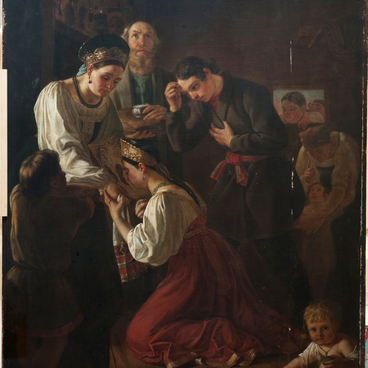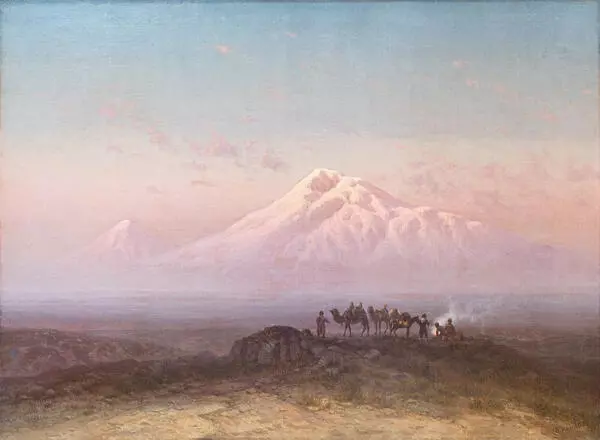Russian painter and graphic artist, master of the mountain landscape painting Ilya Zankovsky was born in Krakow in 1832. He received a military education, served in the rank of second lieutenant. In 1862-1863 he attended classes at the St. Petersburg Academy of Arts as a non-degree student, and in 1864 he was sent to the southern provinces of Russia to have artistic practice. He worked at the General Staff of the Russian Army in Tiflis. Because of the Polish uprising in 1864, Zankovsky, a Pole by origin, was unable to return to St. Petersburg and was forced to quit his art studies.
He continued his service in the Caucasus at the Military Topographical Department of the Caucasus Military District. The artist often went to different parts of the Caucasus on service assignments and painted there. In this way Zankovsky created a large series of landscapes, distinguished by expressiveness and realism. He masterfully worked with light, accurately conveying light effects and color nuances.
Zankovsky noted that unlike many of his colleagues who painted pictures about military events, he was attracted by the nature of the Caucasus. The artist often included genre scenes into his landscapes - sketches about the life of ordinary people. He sought to convey the architecture of settlements and life of the local population accurately from the point of view of ethnography.
In his monumental painting A Road in Kakheti Zankovsky presents the Caucasus through a contrast of two images: subjects of simple, ordinary life in the foreground are emphasized by the panorama of a high mountain range illuminated by the sun. The artist depicted a mountain settlement with typical houses covered with tiles. In front of the house a couple is loading a donkey with a load, next to them there are huge jugs for wine. Two carts drawn by buffaloes are moving one after another along the country road.
Zankovsky tried not to miss any details in order to convey the special atmosphere of the place as accurately as possible. Zankovsky loved the Caucasus, knew its inhabitants and masterfully showed their way of life. Caucasian works of the artist were popular: they were regularly exhibited at exhibitions of the Caucasian Society for the Promotion of Fine Arts and Society of Mutual Assistance of Caucasian Artists.
The painting A Road in Kakheti was bought personally by Emperor Alexander III, who was forming a collection of contemporary Russian art for the Gatchina Palace. Under the name Pre-Highlands of the Caucasus it was exhibited in one of the emperor’s reception rooms — on the first floor of the Arsenal quad.
He continued his service in the Caucasus at the Military Topographical Department of the Caucasus Military District. The artist often went to different parts of the Caucasus on service assignments and painted there. In this way Zankovsky created a large series of landscapes, distinguished by expressiveness and realism. He masterfully worked with light, accurately conveying light effects and color nuances.
Zankovsky noted that unlike many of his colleagues who painted pictures about military events, he was attracted by the nature of the Caucasus. The artist often included genre scenes into his landscapes - sketches about the life of ordinary people. He sought to convey the architecture of settlements and life of the local population accurately from the point of view of ethnography.
In his monumental painting A Road in Kakheti Zankovsky presents the Caucasus through a contrast of two images: subjects of simple, ordinary life in the foreground are emphasized by the panorama of a high mountain range illuminated by the sun. The artist depicted a mountain settlement with typical houses covered with tiles. In front of the house a couple is loading a donkey with a load, next to them there are huge jugs for wine. Two carts drawn by buffaloes are moving one after another along the country road.
Zankovsky tried not to miss any details in order to convey the special atmosphere of the place as accurately as possible. Zankovsky loved the Caucasus, knew its inhabitants and masterfully showed their way of life. Caucasian works of the artist were popular: they were regularly exhibited at exhibitions of the Caucasian Society for the Promotion of Fine Arts and Society of Mutual Assistance of Caucasian Artists.
The painting A Road in Kakheti was bought personally by Emperor Alexander III, who was forming a collection of contemporary Russian art for the Gatchina Palace. Under the name Pre-Highlands of the Caucasus it was exhibited in one of the emperor’s reception rooms — on the first floor of the Arsenal quad.





